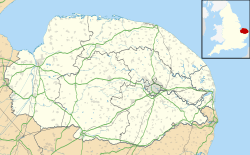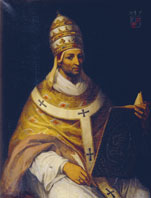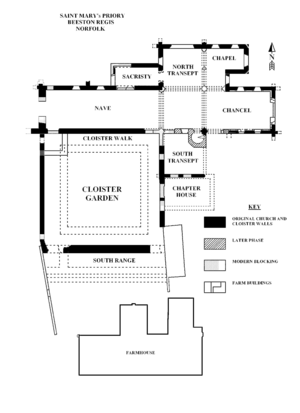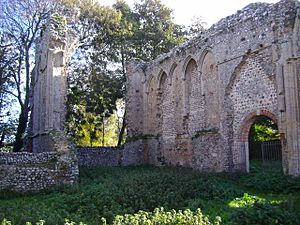Priory of St Mary in the Meadow, Beeston Regis facts for kids
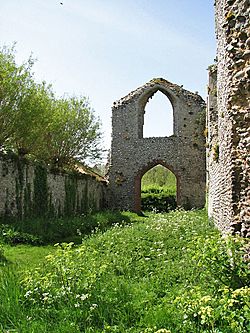 |
|
| Monastery information | |
|---|---|
| Full name | The Priory of St Mary in the Meadow, Beeston Regis |
| Other names | Beeston Priory |
| Order | Augustinian Order |
| Established | 1216 |
| Disestablished | 1538 |
| Dedicated to | St Mary in the Meadow |
| People | |
| Founder(s) | Margery de Cressy |
| Architecture | |
| Heritage designation | English Heritage |
| Site | |
| Location | Beeston Regis, Norfolk |
| Coordinates | 52°56′20″N 1°13′27″E / 52.938772°N 1.224176°E |
| Visible remains | Ruins: open to the public |
The Priory of St Mary in the Meadow, also known as Beeston Priory, is an old Augustinian monastery. It is located in the village of Beeston Regis, Norfolk, in the United Kingdom.
Contents
A Look Back: Beeston Priory's Story
This priory was started in 1216 by a woman named Margery de Cressy. It was dedicated to St Mary in the Meadow. Unlike many smaller monasteries of the Augustinian Order, Beeston Priory was independent. This meant it managed its own affairs.
Life at the Priory
The priests, called canons, who lived at the priory did many important jobs. They served as priests for churches in nearby villages. They also ran a school for boys right at the priory. Boys could either live there (boarding students) or come for the day.
The priory was given a lot of land, about 40 acres (160,000 square meters). It also had special rights to anything found from shipwrecks on the coast. Inside the priory grounds, there were many buildings. These included places for farming, probably a smithy (a place for metalwork), a brewery for making drinks, a guest-house for visitors, and places for washing and toilets. All these buildings were needed to run the busy community.
A Canon's Misadventure
In 1317, something unusual happened. A canon named John de Walsam attacked the Bishop of Norwich with a sword. The matter was serious and was sent all the way to Pope John XXII in Rome.
Luckily, the Bishop recovered from the attack. The pope forgave de Walsam and told the Bishop to arrange a punishment for him.
Checking the Priory's Wealth
In 1291, the priory was checked for taxes. Records showed it had a good yearly value from its lands in Norfolk and Suffolk.
Challenges and Inspections
Monasteries were regularly visited by bishops to make sure everything was running well.
On August 25, 1494, Bishop Goldwell of Norwich visited Beeston Priory. He found that the Prior, John Poty, was the only canon living there. Another canon, Thomas Taverner, had left without permission. The Bishop told Prior Poty to find two new canons quickly.
Another visit happened on July 18, 1514, by Bishop Richard Nykke. Canon Thomas Taverner was still missing! Other canons were present, but there were problems. The Prior would not show the priory's money records. Also, the school was not open, and morning prayers were not being said at the correct time.
Bishop Nykke visited again in August 1532. This time, he found everything in order. A new Prior, Richard Hudson, had just been chosen.
The End of the Priory
In 1535, a survey showed the priory had a good income. It was home to the prior and three canons, six boys at the school, and seven servants. The lead on the roofs and the bells were worth a lot of money, even more than the priory's yearly income!
The priory managed to avoid being closed right away. Prior Richard Hudson and his four canons agreed to accept King Henry VIII's authority over the church. However, the priory was finally closed down in 1538. Prior Hudson received a yearly payment after the closure.
When the priory and its school closed, there was no longer a local school. This is why Sir John Gresham later started Gresham's School in nearby Holt in 1555.
Some old documents mistakenly called Beeston Priory a "Friary." This happened because a person named Sir Richard Rich wrote that the canons "pretended themselves to be friars" in 1538.
After the priory closed, its land and belongings were first rented out by The Crown. Later, they were given to Sir Edmund Wyndham and Giles Seafoule in 1545.
Today, the site is owned by Norfolk County Council. They protect the ruins and have opened them for everyone to visit.
Exploring the Priory Ruins Today
A lot of the main priory church still stands today. The ruins show that the church's main hall, called the nave, was about 75 feet (23 meters) long and 23 feet (7 meters) wide. A chancel (the area around the altar) was added later. The north wall of the nave is still almost as tall as the roof used to be.
The chancel, at the eastern end, also remains quite tall on its north and south sides. The original eastern wall is gone, but a new flint wall has been built up to window height.
The cloister, which was a covered walkway, was to the south of the church. It is now part of the Priory Farm garden. To the east of the cloister, you can still see parts of the walls of the chapter house (where meetings were held) and some signs of the dormitory (where the canons slept). The refectory (dining hall) and other buildings were probably used to build the 18th-century Priory Farmhouse.
The belfry tower is gone, but you can see the first steps of a staircase in a doorway. The west wall of the church is almost completely standing, reaching the height of the gable (the triangular part of the wall).
The north transept (the part of the church that crosses the main body) is 24 feet (7 meters) long and 24 feet (7 meters) wide. One doorway in the transept, which leads to what is thought to be a sacristy (a room for sacred items), is still in its original shape.
West of the transept, there is a small chapel that is 23 feet (7 meters) long and 12 feet (4 meters) wide.
You can also find three old monastic ponds nearby.
People say there's a secret tunnel running from the priory ruins to the Dunstable Arms Inn. But if it ever existed, its location is now a forgotten mystery!
The site is currently owned and protected by Norfolk County Council, who have opened the ruins to the public.
Leaders of the Priory: The Priors
Here is a list of some of the Priors, the leaders of St Mary's Priory:
- Roger, around 1267
- Thomas, around 1297
- William de Beston, 1314-1325
- Geoffrey de Hoton, chosen in 1325
- Simon de Calthorpe, 1390-1409
- Laurence de Beeston, 1409-1416
- Geoffrey de Runton, chosen in 1416 and 1435
- John Poty, 1444-1461
- John Catteson, 1461-1468
- John Wykmer, 1468
- Simon Robyns, 1531
- Richard Hudson, 1532-1538
The last Prior, Richard Hudson, and his four canons all agreed to the Act of Supremacy in 1534. This act made King Henry VIII the head of the church in England. Because they agreed, they were given yearly payments after the priory closed. Richard Hudson later became a priest in another village.
The Priory Maze: A Modern Attraction
Near the priory ruins, you'll find the Priory Maze. This is a popular tourist attraction that also has a cafe-restaurant and a garden centre. The special weather conditions in this part of Norfolk allow the owners to grow many rare and unusual plants.


